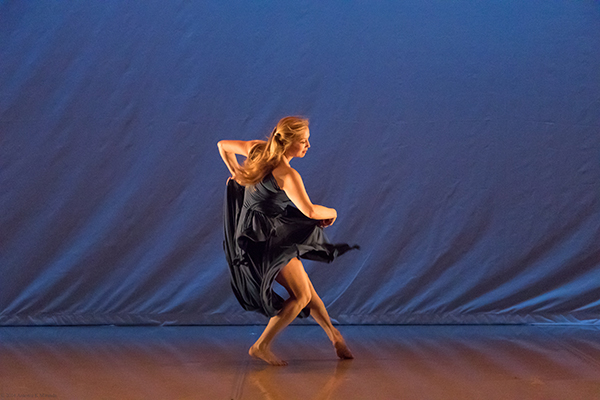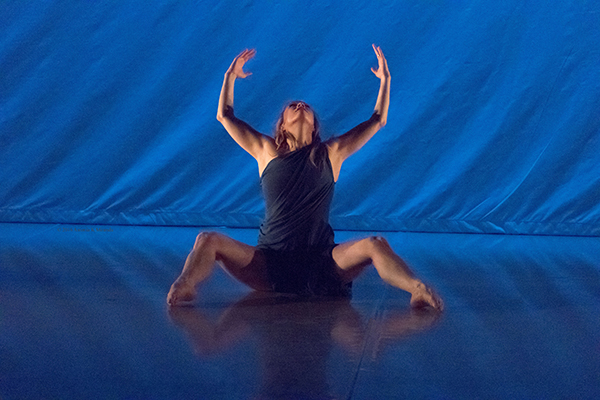Where Modern and Contemporary Meet
An Interview with Sandra Kaufmann
BY EMMALY WIEDERHOLT
Sandra Kaufmann performed in the Martha Graham Dance Company before serving as the founding director of the dance program at Loyola University. As an educator and practitioner, she shares her perspective on contemporary dance and where the form is headed. This interview is part of a series on contemporary dance and its extended implications.
~~
How would you define contemporary dance to someone unfamiliar with dance?
A large part of my career has been devoted to distinguishing between contemporary dance and modern dance. Contemporary dance is the dance that is happening now. It has interdisciplinary influences in terms of the other contemporary arts, including music, text, spoken word and digital media.
For example, Mark Morris is making work right now, but his work is more classical. Contemporary dance is on the edge, trying new things directly related to the “now” of society. Classicism has a timelessness about it. Contemporary dance is firmly positioned in the “now,” and involves exploration of what’s currently happening in terms of culture and technology.
What training would you recommend to a student who is interested in pursuing contemporary dance?
It’s something I give quite a bit of attention to since I run a university dance program. Disclaimer: My background is in classical modern dance; I danced with the Martha Graham Company for 10 years, and did Doris Humphrey, Charles Weidman and Isadora Duncan repertoire for 20 years. I’m steeped in that tradition. But I recognize that can’t be all I give my students.
When our dance program was just starting out, we only offered Graham modern technique twice a week, as I was the only teacher. Now we offer ballet five times a week, modern dance four times a week, and experimental forms twice a week, which can include release technique and improvisation. We also make a great effort to have contemporary artists set new work on our students.
The other thing I see in contemporary dance is much interdisciplinary fusion going on. Contemporary dancers need the foundation of ballet and modern, but they should also be able to do hip hop, jazz, and be able to speak on stage. Contemporary dancers are also regularly called upon to generate movement for choreographers in a way that I did not experience in classical modern dance. They need to be open, versatile and in many ways very creative as artists as well as dancers. We’re seeing the contemporary dancer have virtuosic technique but be a performance artist as well.
Do you think there will be a post-contemporary era?
Maybe. Perhaps what could be post-contemporary dance is when dance goes back to being just dance, and we stop feeling the need to incorporate video, soundscapes and spoken text. Maybe we’ll go back to proscenium theaters with lighting, because right now people dance in all sorts of spaces. There’s also a lot of incorporation of technology, and perhaps there will be a backlash against that as well.
Do you think the funding models for contemporary dance are different than for classical dance companies?
This is a larger issue, and something to which I’ve given a great deal of thought. The company model in dance is not shoring up anymore. Here in Chicago, Luna Negra Dance Theater closed, the second company of Hubbard Street Dance is closing, and River North Dance is closing. Artistic directors of several major dance companies in New York are really struggling. Dance, of course, never has any money, but the company model is flailing. We’re seeing that dancers have to find other work outside of a company. It’s not enough to just be a dancer; instead, maybe you’re working in PR, photography or marketing…dancers have to branch out beyond getting a dance degree and just dancing. That’s a myth.
Increasingly, dance is very project-oriented. Dance artists enter partnerships in order to find their funding. It’s increasingly individualized. Dance-makers will work with dancers in a repeated way, but won’t have a company per se. It’s more like a pick-up company per project.
So dancers have to be versatile in many forms of dance and then have the ability to do other kinds of work to support themselves between projects. It’s both empowering and scary that dancers have to be jacks of all trades. Do you think this is a good thing, or will there be a backlash?
I don’t know. Our dance culture as artists and athletes—we have to address and maintain the wellness of our bodies in a way that’s not present in other arts—has the least money and is the most expensive to present. I don’t know how many performances I’ve done where the costumer will get paid but the dancers might not. The theater staff, the marketing…all these jobs get paid before the dancers. And I’ve been on panels where people say, “Nobody should ever do anything for free.” If that was the case, dance wouldn’t happen. And if you are getting paid, it’s pennies on the hour. This is the water we swim in. There’s the famous quote when a student asked Martha Graham if she should be a dancer, and Martha responded something like, “If you have to ask, the answer is ‘no.’” We do this because we have to. It’s never going to be comfortable.
In our university program, we want our students to be their own advocates and leaders. The passive model of working for an authority figure who will make decisions and provide a career just doesn’t exist in contemporary dance. What you’re seeing is a very educated and dynamic group of primarily women (and some men) who do this because they simply have to. This is where they get meaning in life. The rewards are great enough that they continue to press on. We’re going to do this no matter what. That’s got to be the mentality. And when you approach the field in that regard, some really extraordinary things can happen. But it’s no easy road. You have to be a very complete person to be successful.
What do you perceive is your contribution to the contemporary dance arena?
My work has been scathingly criticized for being too lyric, too old-fashioned, too beautiful, too ambitious. But I want to get at those timeless things. I’m really not a contemporary dancer. I feel like my contribution is the derriere-garde, not the avant-garde. I really believe in people connecting to each other onstage to beautiful music. Not that I haven’t done a lot of site-specific and interdisciplinary video work; I’ve done that and really enjoyed it. But if I was going to distinguish my contribution, my work tends to be modernist. I’m looking to have a message and have intent, whereas often in contemporary dance, choreographers are unwilling to express any intention whatsoever. The audience will get what they get; there’s a deliberate ambiguity. I’m not saying things can’t be multidimensional and classical work can’t have layers of ambiguity as well, but the idea of a choreographer having a true intent and pursuing a work of art with a vision is something I’ve never been able to get away from and have been criticized for.
Any other thoughts?
I am an old-fashioned modernist running a program where I’m trying to prepare young people to go into the contemporary dance world. These are questions I’ve given a lot of thought to, how best to serve our students and promote the art form.
~~
Sandra Kaufmann is internationally recognized as an authority on classical modern dance technique and repertory with extensive experience as a dancer, director and educator. She is the founding director of the dance program at Loyola University. Sandra performed throughout the world as a member of the Martha Graham Dance Company. While based in New York City, she served on the faculty of the Martha Graham School of Contemporary Dance and as artistic director of the Martha Graham Ensemble. She also performed extensively with choreographers Pearl Lang and Richard Move. Sandra has taught Humphrey/Weidman technique and theory on faculty at Barnard College and New York University and as a repeat guest artist at Interlochen Academy. She serves as a member of the board of the Doris Humphrey Society. A prolific choreographer, she has created works for concert dance, musical theatre productions, opera, video and site specific works.


